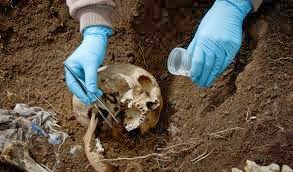Investigating murders incorporates a host of
different forensic professionals, all scientifically collaborating in an effort
to corroborate their findings. Forensic entomology combines the study of
insects and other arthropods with criminal investigations. In the case of a
forensic entomologist; their job, when investigating a homicide, is to help
determine the postmortem interval (or time elapsed since death; PMI) of a
corpse based on the age of the insects present in the body. To do so, they must
first identify the species of the insect. Each species of insect may have
vastly different habits, behaviors, and growth rates.
Forensic entomologists must consider the time it
takes for each species of fly to reach the body and the rate of development for
each species. For instance, some species lay eggs in an outdoor environment and
some lay eggs in an indoor environment. Therefore, if a corpse is recovered
indoors and has eggs or larvae of flies that typically inhabit sunny outdoor
locations, this would indicate that the body was moved. Once the entomologist
determined the “Time Since Colonization (TSC),”
they can determine the PMI.
These professionals use a variety of different techniques, such as species succession, larva weight, larva length, and others to determine the TSC. In any event, it also beneficial to have a forensic pathologist, a medical examiner, or coroner to estimate the PMI and the forensic entomologist may assist them if necessary. Combining the analysis of all of these specialists is not only necessary; it also narrows the margin for error, providing several scientific explanations for the same process. The more scientific results that are accumulated; the more valid the results become. In some cases, however, a forensic entomologist is not only the best way, but sometime the only way to determine the PMI. Dr. Gail Anderson, a forensic entomologist at Simon Fraser University in Vancouver, Canada, suggests that “after three days insect evidence is often the most accurate, and sometimes the only, method of estimating the elapsed time since death.
It is very realistic to use a forensic entomologist
to estimate the PMI. In fact, they have been used in countless cases to do just
that. For example, there is a recent case in which police received a call to
investigate a foul smell coming from a nearby home in the southeastern part of
the United States. During their investigation, police discovered the badly
decomposing body of a young woman buried in a shallow dirt grave in the
basement, who had apparently died of a single gunshot to the head. An
examination of the corpse and excavated soil in and around the grave site,
conducted by a forensic entomologist, revealed the presence of several larvae
and pupae of two different fly species, the longest were in their fourth stage
of development. Based on this, the forensic entomologist was able to determine
that the victim died roughly 28 days prior to the discovery of the body. Soon
after, police identified a female suspect who eventually confessed to the
crime, claiming that she killed the woman and buried her in the shallow grave
exactly 28 days prior to the discovery of the body.
The rate at which a body decomposes is based on
several factors: air temperature, layers of clothing, types of wounds, and so
on. One of the best ways in which to identify a victim that is in advanced
stages of decomposition is with a forensic odontologist using dental records. The
pattern of fillings, crowns, missing teeth, and x-rays can all serve the
identification process. Dental prosthetic tooth replacements—i.e. dentures,
bridges, and partials—can also aid in identification and may potentially
provide information such as geographic origin, approximate dating of
construction, and even a link to a
particular dentist or lab.
If traditional methods of identification fall short,
methods such as superimposition and facial reconstruction can be used. DNA
comparisons are also a great way to identify a decomposing corpse.
Mitochondrial DNA can be conducted on bone and compared to the suspect’s
mother, if law enforcement has a hunch who the person is. Examining the
internal organs can also yield results of any conditions that the corpse may
have suffered from while alive. This can be compared to medical records. Another
is medical implants, such as pacemakers, breast implants, and so. These can
also yield identification results, as they all have a serial number etched on
them.
In cases where remains are decomposed, burned, or
otherwise unrecognizable, a forensic anthropologist can offer assistance in a
criminal investigation. In such cases, forensic anthropologist’s can assess the
individual’s age, sex, ancestry, racial classification, and more. For example,
in the case of John Wayne Gacy, investigators brought in forensic
anthropologists, Charles P. Warren and Clyde C. Snow, to analyze a number of bones
from different victims that were dug up. They were able to determine that the
typical victim was a Caucasian male in his teens or early twenties.



Thanks for sharing us about your site.
ReplyDeleteimplant dentistry naples fl